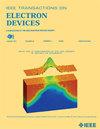考虑Peltier效应和Thomson效应的4H-SiC GTO晶闸管修正热模型
IF 2.9
2区 工程技术
Q2 ENGINEERING, ELECTRICAL & ELECTRONIC
引用次数: 0
摘要
碳化硅(SiC)栅极关断晶闸管(GTOs)具有高电流密度、高阻断电压、高开关频率和优异的热阻等特点,非常适合作为脉冲电源系统中的脉冲开关。然而,它们的可靠性仍然是一个迫切需要关注的关键问题。由于忽略了p-n结电压对热分布的影响,目前对碳化硅GTOs热失效机理的研究有限。在这项工作中,修正了热力学模型中的塞贝克系数(S),首次考虑了先前被忽视的由塞贝克效应在4H-SiC GTOs中引起的Peltier和Thomson热。仿真分析表明,改进后的模型能够较准确地捕获GTO阳极下的局部热集中。修正后的模型预测在阳极下方的6- $\mu $ m区域内产生的热量约为$1\乘以10^{{9}}$ W/cm2。这一结果突出了该模型捕捉塞贝克效应的能力,这在默认的TCAD模型中被忽略了,为4H-SiC GTOs和其他双极功率器件的热行为提供了更准确的表示。本文章由计算机程序翻译,如有差异,请以英文原文为准。
Modified Thermal Model Considering Peltier Effect and Thomson Effect for 4H-SiC GTO Thyristors
Silicon carbide (SiC) gate turn-off thyristors (GTOs), distinguished by their high current density, high blocking voltage, high switching frequency, and excellent thermal resistance, are highly suitable as pulse switches in pulsed power systems. However, their reliability remains a critical issue requiring urgent attention. Existing research on the thermal failure mechanisms of SiC GTOs is limited, partly due to the neglect of p-n junction voltage effects on thermal distribution. In this work, the Seebeck coefficient (S) in the thermodynamic model is modified, which considers for the first time the previously neglected Peltier and Thomson heats induced by the Seebeck effect in 4H-SiC GTOs. Simulation analysis reveals that the modified model captures localized heat concentration beneath the GTO anode with enhanced accuracy. The modified model predicts approximately $1\times 10^{{9}}$ W/cm2 more heat generation within the 6- $\mu $ m region beneath the anode. This result highlights the model’s ability to capture the Seebeck effect, which was omitted in the default TCAD model, providing a more accurate representation of the thermal behavior in 4H-SiC GTOs and other bipolar power devices.
求助全文
通过发布文献求助,成功后即可免费获取论文全文。
去求助
来源期刊

IEEE Transactions on Electron Devices
工程技术-工程:电子与电气
CiteScore
5.80
自引率
16.10%
发文量
937
审稿时长
3.8 months
期刊介绍:
IEEE Transactions on Electron Devices publishes original and significant contributions relating to the theory, modeling, design, performance and reliability of electron and ion integrated circuit devices and interconnects, involving insulators, metals, organic materials, micro-plasmas, semiconductors, quantum-effect structures, vacuum devices, and emerging materials with applications in bioelectronics, biomedical electronics, computation, communications, displays, microelectromechanics, imaging, micro-actuators, nanoelectronics, optoelectronics, photovoltaics, power ICs and micro-sensors. Tutorial and review papers on these subjects are also published and occasional special issues appear to present a collection of papers which treat particular areas in more depth and breadth.
 求助内容:
求助内容: 应助结果提醒方式:
应助结果提醒方式:


